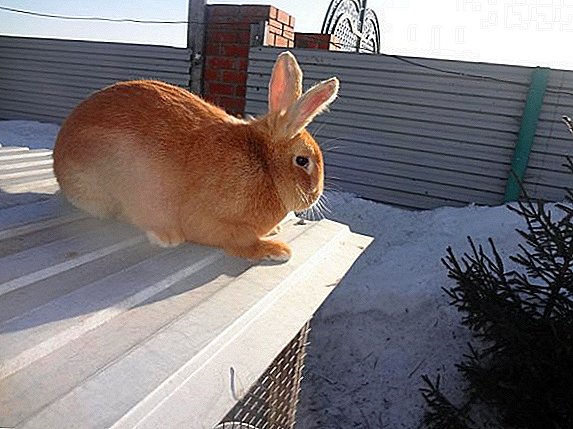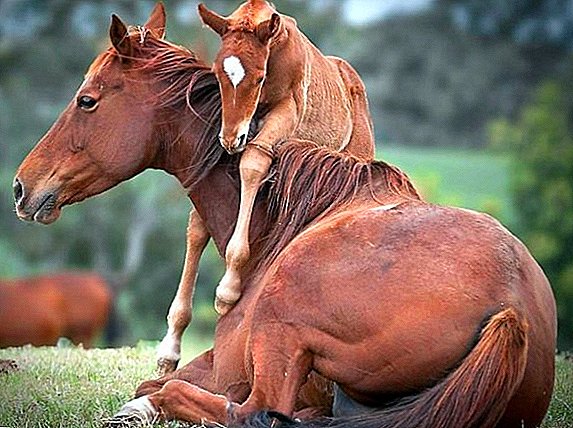 The duration of pregnancy in a horse depends on the timing of insemination, pedigree characteristics, conditions of detention. Pregnancy can last from 11 months to a year, during this period the fetus significantly increases in size, and the mare's physiological needs change. The care and feeding of the horse during pregnancy must be special, and its further health depends on the restoration of the animal in the postpartum period. This article will discuss the characteristics of horse colt, the principles of caring for a colt, the order of chicks, and the care of a newborn baby.
The duration of pregnancy in a horse depends on the timing of insemination, pedigree characteristics, conditions of detention. Pregnancy can last from 11 months to a year, during this period the fetus significantly increases in size, and the mare's physiological needs change. The care and feeding of the horse during pregnancy must be special, and its further health depends on the restoration of the animal in the postpartum period. This article will discuss the characteristics of horse colt, the principles of caring for a colt, the order of chicks, and the care of a newborn baby.
Pregnancy in horses
The foal comes from the moment of insemination, but since the mare is inseminated several times during a hunt, it is difficult to determine the exact date of fertilization.
Important! Sexual maturity in these animals comes to one and a half years, but physiologically, such a horse is not yet ready to bear a healthy fetus, therefore, the first insemination is carried out at least at the age of three.
How to determine
In total there are four ways to determine the foal - folk, clinical, instrumental and laboratory. 
Folk way
Visual changes become noticeable in the fifth month of the foal. The mare begins to bulge the abdominal walls, the left side becomes more round and lowered. When covering the mare with a sheet and listening to the peritoneum with a phonendoscope, the foal's heart tones are heard.
Check the presence of the fetus can also be palpation. When pressed on the side of the mare, the fruit will move, and then return to it with a noticeable push. Palpation should be carried out as carefully as possible, in no case do not press the fist and do not hit the mare on the side. These methods are effective for late terms of the foal.
Learn about horse harness, how to saddle and harness a horse.Another test method is the test stallion method. Crested stallion run in the cage to the mare in the period of the alleged hunting. If she does not show sexual activity, then the insemination is successful.
Diagnosis of colts on the external signs: video
Did you know? In 1975, the world's smallest foal was born. The kid named Pumpkin belongs to a miniature American breed. His weight at birth was a little over 9 kg, and height - 35 cm. Miniature horses are bred to participate in exhibitions and used as guide dogs. Most often, the guides are representatives of the Falabella breed. These animals are intelligent and intelligent, easily find their way in crowded places and quickly become attached to the owner.
Clinical method
Includes rectal and vaginal examinations. They are carried out by inserting a gloved hand into the anus or vaginal opening of the mare.
The vaginal method is rarely used, because during the examination it is possible to damage the fetus and carry infectious diseases. The rectal method gives an accurate result.
To inspect the horse is fixed in the machine, tie up the tail and expand the anus to provoke defecation. After the fecal mass is released, the arm is inserted into the anus and groped uterine horns.  If the mare is not pregnant, the uterine horns will be equally small. In a horse stall, the horn in which the fetus develops will begin to round off and gradually descend into the abdominal cavity. Significant changes in the horns and the development of the fetus in it begin to appear in the second month after fertilization.
If the mare is not pregnant, the uterine horns will be equally small. In a horse stall, the horn in which the fetus develops will begin to round off and gradually descend into the abdominal cavity. Significant changes in the horns and the development of the fetus in it begin to appear in the second month after fertilization.
Important! A vaginal examination is performed if the mare has intestinal problems. For such an inspection a special mirror is used. Sexual passages in first-breed mares are severely narrowed, therefore, the mirror should be inserted very carefully. If the mare was fertilized, the entrance to the uterus will be closed by a dense mucous mass.
Instrumental way
Ultrasound is considered the most informative and safe for the mare and foal. Ultrasound makes it possible to determine the foal already on the tenth day after fertilization.
After fixation of the animal and its defecation, a sensor lubricated with lubricant is introduced into the anus. They are led through the mucous membrane and with its help inspect the horns of the uterus. On the tenth day of the foal, the embryo will be visible on the display, and on the twentieth - already the embryo. This is the most reliable way to diagnose pregnancy.
 Ultrasound mare stallion
Ultrasound mare stallion
Laboratory method
It consists in taking a blood test and smear from the vaginal mucosa. On the third week after insemination in the blood of the mare, the level of progesterone, a pregnancy hormone, rises. Progesterone protects the fetus from abortion and inhibits the sexual activity of the mare.
Did you know? Horses never existed in North America and Australia until the European colonialists brought them there in the 14th century. The artificially introduced livestock quickly became aboriginal, and the individuals who had escaped or released were breeding into huge herds, now known as the population of mustangs.
A smear of mucus is checked on a glass slide after treatment with alcohol and staining. If the horse is pregnant, the mucus under the microscope will have the appearance of small blue balls interspersed with epithelium fragments and individual leukocytes.
Horse mucus that has not been fertilized will look uniform and consist of white blood cells along with a flat epithelium. This method is considered not the most reliable, it can be used from the fourth month of the intended pregnancy. 
How long does it take
The average gestation period ranges from 320 to 350 days. The duration of pregnancy depends on the size of the fetus, the breed of the mare and stallion, the duration of estrus, the number of cases, the conditions of the animal. Among veterinarians there is an opinion that female individuals are born on average two weeks before males.
How many foals can give birth
The maximum number of foals received from one colt is two. If the mare bears two fruits, it is significantly depleted, and both foals are born weak or dead. Most often, one fruit is stillborn, and the other is healthy. Normally, a mare bears and gives birth to one foal.
Important! If the birth of a multiple pregnancy is normal, the second foal will appear 10 minutes after the birth of the first one. In this case, you can not allow the mare to turn its tail to the wall or fence, otherwise the second baby will be crushed.
Care and Feeding with Foals
If the colt fell on summertime, then the uterus should be kept on grazing for 5-6 hours a day. There she will feed herself by the green mass. In winter, a pregnant mare should be transferred to a concentrated diet - to give oats, corn, wheat bran, high-quality meadow hay.  Need to avoid feed, which provoke fermentation - bagasse, bards, wet mass of legumes, yeast. You can tackle mares with exceptionally warm clear water - cold water provokes abortions in the early stages.
Need to avoid feed, which provoke fermentation - bagasse, bards, wet mass of legumes, yeast. You can tackle mares with exceptionally warm clear water - cold water provokes abortions in the early stages.
A pregnant horse has a particular need for vitamins A, E, calcium and phosphorus. This shortage can fill the carrots, flavored with vegetable oil, which is crushed and give twice a day in portions and a half kilograms.
Did you know? In July 2006, an entry about the world's smallest filly appeared in the Guinness Book of Records. The horse named Tambelina was born in the US state of Missouri and with its height of 44 cm holds an undeniable championship among horses to this day.
It is necessary to feed the mare more often (up to five times a day) and to reduce her portions, since the growing fetus takes up a lot of space in the abdominal cavity. Sprouted wheat is added to the diet starting from the fourth month of foal - it will reduce the risk of abortion, will become a source of calcium, vitamins E and B.  In the warm season, the mare must be kept on pastures with shelters from hot and rainy weather, driven into a stall at night. In winter, the mare needs to be walked at least 4 times a day; on rest, take it to a warm and dry stall with deep hay bedding. It is recommended to clean the stall daily, as the pregnant mare often smears litter.
In the warm season, the mare must be kept on pastures with shelters from hot and rainy weather, driven into a stall at night. In winter, the mare needs to be walked at least 4 times a day; on rest, take it to a warm and dry stall with deep hay bedding. It is recommended to clean the stall daily, as the pregnant mare often smears litter.
To clean the horse's skin you need a soft brush or a bunch of clean hay. The groomer during this period is irritating to the animal. Use a pregnant horse to work carefully. Starting from the ninth month of pregnancy, it is recommended to give her a complete rest.
Chubby (maternity) with mares
Births in mares are called chaff, that is, the birth of a foal. They pass within 30-40 minutes, but the first signs of a chaff may appear 2-3 days before the start of contractions.
Learn how to feed a horse and what feedings to use for healthy looking hooves, wool and joints.
Room preparation
Horse deliveries begin late at night or early in the morning and usually last about half an hour if they pass without complications. Begin to prepare for the colt a few hours before the estimated time. Clean, disinfect and cover with a stallion of a horse with fresh deep bedding, dim the light in the stall.
It is also recommended to cover the litter with a clean, natural cloth. Shortly before giving birth, the horse begins to turn around on its croup, worry, lie on its side and sweat a lot. At this point, you need to free the stall from outsiders and no longer disturb the mare.
How to prepare for the chubby: video
Important! A horse in front of a chaff can be calm. In this case, a sure sign of approaching labor will be a large amount of mucus on her labia and frequent attempts to rub the tail against the walls of the stall.
How horses give birth
If the colt passes without complications, the foal emerges from the birth canal with its claws and muzzle forward. The chest of the foal is the hardest. Further delivery takes no more than 5 minutes. In the process of childbirth, the mare may roll on the floor, wag his tail, and kick his hind legs.
A veterinarian interferes with the process only if the fetus is in the wrong position in the womb or the horse is too weak to push it out on its own. He can hold the horse's legs or help the fetus to advance along the birth canal.
Did you know? Up until the first decade of the 20th century, the problem of horse manure and urine was the most serious problem of pollution in European and American cities. At the end of the 19th century, in New York, there was a half-million horse population that compensated for the shortage of vehicles, and only the appearance of cars three decades later solved this problem.If the horse gives birth while standing, the foal falls out of the birth canal, and the umbilical cord is torn itself. The horse giving birth lies up a few minutes after the colt, and thus cuts the umbilical cord.
 The fruit is born in the film blue-blue bubble. Normally, the bubble bursts itself, but if this does not happen, tear it apart with your hands and wipe the foal's muzzle from mucus with a clean cloth.
The fruit is born in the film blue-blue bubble. Normally, the bubble bursts itself, but if this does not happen, tear it apart with your hands and wipe the foal's muzzle from mucus with a clean cloth.The baby starts to get up on its feet 40-50 minutes after birth. During this time, you need to wash the horse's udder and hind legs with warm water and change the soiled litter.
A horse that has not given birth usually rests for 10–15 minutes, and then begins to lick the foal, sniff it and bite it, so that it will rise to its feet. The baby begins to feed on mother's milk in an hour and a half after birth.
Important! Two and a half hours after birth, meconium (first feces) should be released from the foal. If this does not happen, it is necessary to stimulate defecation by inserting a finger into the anus of a foal or feeding him a few spoons of castor oil.
If the sucking reflex did not appear during this time, wait another half hour, milk the mare and give the colt some milk.

Postpartum period
Postpartum discharge from the horse is stopped on the seventh day, so during this time the litter in the stall needs to be changed daily. The placenta must go within 3 hours after delivery. If he doesn’t come out or doesn’t go out entirely, contact your veterinarian for help, since the last in the uterus may cause its inflammation.
5 hours after giving birth, give the horse a warm boil of bran, give him a bunch of better hay.
Check out the rules for choosing names for foals.
During the week after birth, carefully monitor the state of the mare and foal. The baby should often suck the udder (up to 40 times a day) and rapidly gain weight (from 500 g to 1 kg per day).
In a healthy mare, the udder will be poured, but not inflamed, it will be active and calm. The diet of the birth mare is not much different from the usual. It should include a large amount of water, high-quality hay and abundant vegetable feeding. If desired, enter into the diet mares sour-milk cottage cheese and boiled chicken eggs.
What to do if the mare refuses to feed the foal: video
Three days after giving birth a horse with a baby can be let out for the first walk, and after another two weeks you can connect the horse to work, gradually increasing the load. To separate a foal from a horse should not be, as it will start to get nervous, distracted, it can break out and run into a stall.
Keep your baby close to his mother, let him often feed on milk. At this time, he grows intensively, begins to imitate the behavior of an adult individual and the separation from the mother will have a negative impact on his health. The removal of the foal can be carried out at the age of 6-7 months, by this time it will become independent, and its relationship with the mother will begin to weaken.
Did you know? From the beginning of the XIX century to the beginning of the XXI, the record of weight and height among the horses belonged to the giant gaure named Samson. This stallion weighed almost a half tons and growth was more than two meters. This record was broken only in 2010 by a Belgian stallion named Big Jack. Jack was born in Wisconsin, USA, and at the age of three reached a unique height of 2 m 10 cm. He is the largest stallion in the world.
Pregnancy in horses is called foal and normally lasts about 11 months. It can be determined by external or internal examination, instrumentally, as well as with the help of laboratory tests. Most often the mare gives birth to one foal, less often two.  As soon as the horse begins to show signs of approaching labor, it is necessary to prepare a stall for it and invite an observing veterinarian. If childbirth passes without complications, the mare is fully restored in the second week after the colt and can be used again.
As soon as the horse begins to show signs of approaching labor, it is necessary to prepare a stall for it and invite an observing veterinarian. If childbirth passes without complications, the mare is fully restored in the second week after the colt and can be used again.












